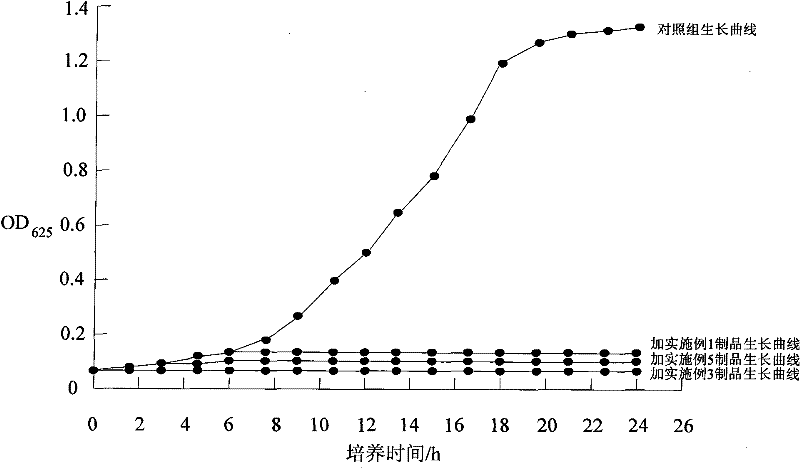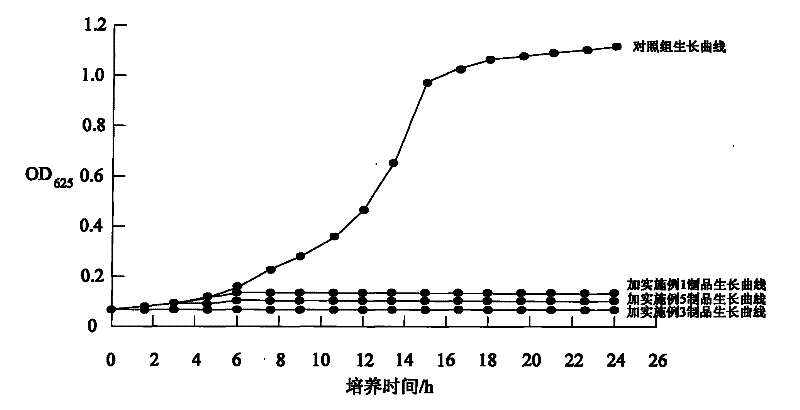Long-acting low-corrosiveness feed mould inhibitor
A corrosive and antifungal agent technology, applied in the field of feed antifungal agents, can solve the problems of high health hazards for production personnel, high corrosiveness of production equipment, and the antifungal effect is not as good as propionic acid, so as to improve the antifungal effect and prolong the production life. The life of the ring die and the effect of enhancing the anti-mildew and anti-bacterial effect
- Summary
- Abstract
- Description
- Claims
- Application Information
AI Technical Summary
Problems solved by technology
Method used
Image
Examples
Embodiment 1
[0029] Weigh 1200g of propionic acid and 200g of ammonium bicarbonate according to mass parts, and add them to the reactor, the temperature is controlled at 80°C, and the stirring speed is 120 revolutions / min. After 4 hours of reaction, 100 g of ammonium bicarbonate, 15 g of acetic acid, 20 g of benzoic acid, 15 g of sorbic acid, 20 g of citric acid, and 25 g of ethanol were added, and the reaction was continued for 3 hours to obtain a feed antifungal agent product. The above-mentioned product is a liquid with a pH of 5, and the amount directly added to the feed is 400 g / ton feed. After mixing 300g of liquid product and 500g of hulling, the dosage ratio in the feed is 1000g / ton of feed.
[0030] Example 1 Determination of antibacterial effect of products
[0031] 1. Determination of the minimum inhibitory concentration (MIC) of the product of Example 1:
[0032] Take bacteria (Staphylococcus aureus, Escherichia coli, Salmonella, Bacillus subtilis), molds (penicillium, Aspergillus),...
Embodiment 2
[0044] Weigh 2500g of propionic acid and 900g of ammonium bicarbonate according to mass parts, and add them to the reactor, the temperature is controlled at 75°C, and the stirring speed is 100 revolutions / min. After the reaction for 4 hours, 600 g of ammonium bicarbonate, 200 g of acetic acid, 400 g of benzoic acid, 200 g of sorbic acid, 400 g of citric acid, and 400 g of ethanol were added, and the reaction was continued for 4 hours to obtain a feed antifungal agent product. The above-mentioned product is a liquid with a pH of 5, and the amount directly added to the feed is 450 g / ton feed. After 350g of liquid products, 100g of white carbon black and 450g of vermiculite are mixed, the dosage ratio in the feed is 1500 / ton of feed.
[0045] Example 2 Determination of antibacterial effect of products
[0046] 1. Determination of the minimum inhibitory concentration (MIC) of the product of Example 2: The test method is the same as that described in Example 1, and the measurement resu...
Embodiment 3
[0053] Weigh 3500g of propionic acid and 1600g of ammonium bicarbonate according to mass parts, add them to the reactor, control the temperature at 85°C, and stir at 120 revolutions / min. After 4 hours of reaction, 900 g of ammonium bicarbonate, 500 g of acetic acid, 800 g of benzoic acid, 500 g of sorbic acid, 800 g of citric acid, and 800 g of ethanol were added, and the reaction was continued for 3 hours to obtain a feed antifungal agent product. The above-mentioned product is liquid with a pH value of 5.5, and the amount directly added to the feed is 500g / ton feed. After mixing 400 g of liquid products, 100 hulls and 500 g of zeolite powder, the dosage ratio in the feed is 1000 g / ton of feed.
[0054] Example 3 Determination of antibacterial effect of products
[0055] 1. Determination of the minimum inhibitory concentration (MIC) of the product of Example 3: The test method is the same as that described in Example 1, and the measurement results are shown in Table 3-1.
[0056] ...
PUM
 Login to View More
Login to View More Abstract
Description
Claims
Application Information
 Login to View More
Login to View More - R&D
- Intellectual Property
- Life Sciences
- Materials
- Tech Scout
- Unparalleled Data Quality
- Higher Quality Content
- 60% Fewer Hallucinations
Browse by: Latest US Patents, China's latest patents, Technical Efficacy Thesaurus, Application Domain, Technology Topic, Popular Technical Reports.
© 2025 PatSnap. All rights reserved.Legal|Privacy policy|Modern Slavery Act Transparency Statement|Sitemap|About US| Contact US: help@patsnap.com



